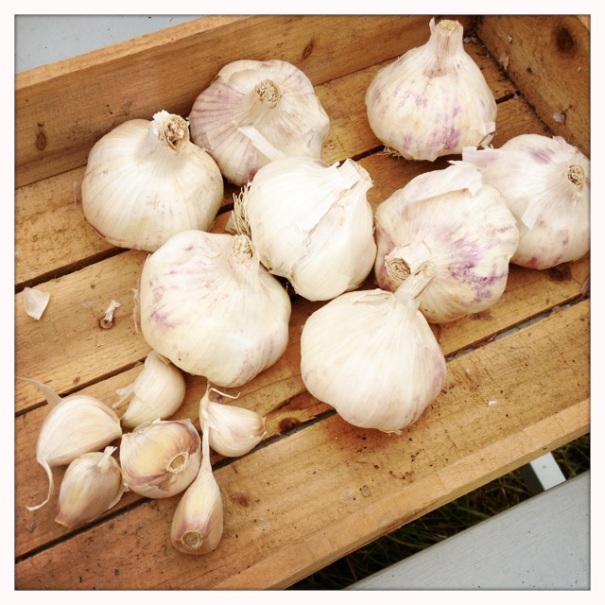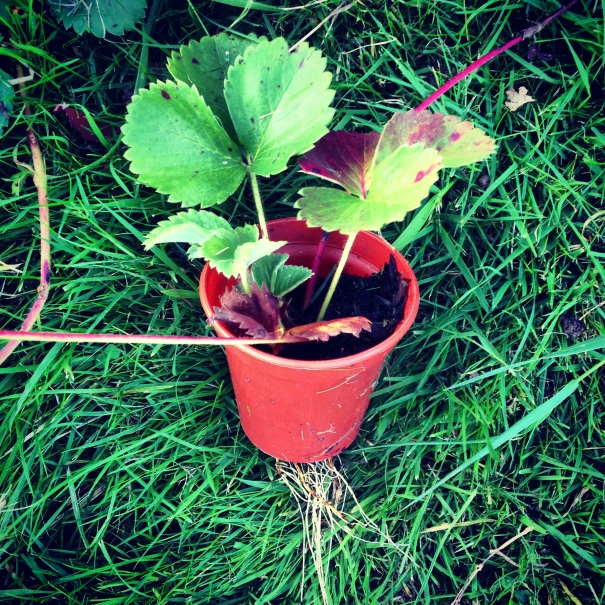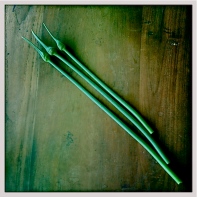Typically we plant garlic around mid October, but the weather has been unseasonably warm this year. Garlic needs a good spell of cold weather to promote germination, but with temperatures roughly 4 degrees celsius above the average for this time of year, there’s been no rush. We finally made the decision to plant the garlic at the end of October, which turned out to be fairly good timing. Air temperatures plummeted in early November, falling from around 20 degrees C, down to around 11 degrees C.
We had planned to plant a variety called Early Purple Wight, however all best plans and that, this variety wasn’t actually available in the garden centre this year. As an alternative we chose two softneck varieties, Germidour and Iberian Wight.
Germidour is a French variety that is well adapted to the British climate. It should produce a fairly large white bulb, with pink tinges and it has a mild but rich flavour
Germidour seed garlic bulbs
Iberian Wight is a variety from the Cordorba region of Spain. It prefers a milder climate but should grow well on the south coast. It produces a large flat, white skinned bulb, which has a fairly strong flavour. This variety is known to push up out of the soil as it grows so it should be planted at least 2 inches deep.
Iberian Wight seed garlic bulbs.
We’ve planted the majority of the garlic on the orchard plot, in the bed where we grew the potatoes this year. This soil has broken down well and as we earthed the potatoes up with bags and bags of old compost, this bed is full of organic matter, making it fairly free draining. In the past we’ve planted the garlic cloves only about an inch deep because the soil is heavy clay making the seed cloves at risk of rotting. This year we’ve decided to plant them deeper, two inches given the better soil structure. This should result in larger garlic bulbs, assuming the seed cloves don’t rot following all the recent heavy rainfall we’ve experienced . The garlic cloves have been planted 8 inches apart, and we’ve spaced the rows 12 inches apart.
We planted a total of 55 garlic cloves on the orchard plot and a further 20 cloves on plot 2. When the growing tips emerge we shall fleece the bed to protect the plants from the frost, plus to help prevent pesky bird attack!
Last year, as an experiment, we grew some garlic cloves in modules and transplanted the young plants to the allotment in the spring. These plants didn’t grow as well as the garlic we planted in situ. Based on this, we are growing all our garlic in situ this year.
The strawberry runners that we potted up at the beginning of September have developed lovely strong root systems and can now be cut free from the parent plants.
The comfrey that we cut down on plot 2 a few weeks ago is already growing back well.
When we took over plot two there was a seam of comfrey running across the entire plot. If not controlled it can become like a weed, even the slightest fragment of root left in the ground produces foliage. We’ve removed roughly half the seam over the past year, but have retained the rest because comfrey is an hugely beneficial plant to have on an allotment.
Comfrey roots grow large and can reach down to depths of 8 to 10 feet. Think of comfrey as a ‘nutrient pump’. The plant extracts minerals and nutrients from deep down in the soil structure, bringing these nutrients to the surface and storing them in the leaves. It’s possible to cut the plants leaves down 3 to 4 times a year. These leaves can be used as a mulch, added to compost or used to make a liquid feed.
We’ve managed to save a lot of garlic chive seed despite the wet weather
The leeks continue to grow well
And finally I have great sympathies with this fellow allotmenteer…..



























Leave a comment